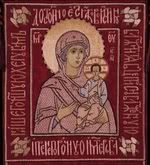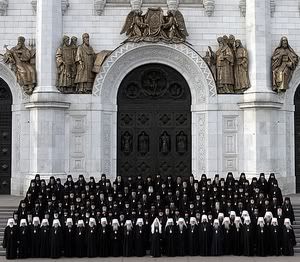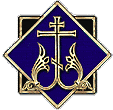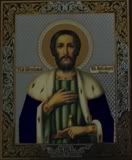Taraskovyan Orthodox Church
| Taraskovyan Orthodox Church Vigvar Patriarchate | ||||||
|---|---|---|---|---|---|---|
|
| ||||||
|
The history of Orthodoxy in Tarasovka is one of many dark and also bright moments, a process forever tied to the fate of the entire Taraskovyan nation. Today, claiming three quarters of Taraskovyans as faithful, the Taraskovyan Orthodox Church is not only the largest single religious denomination in the Grand Duchy, but is also one of the leading Churches in the Eastern Orthodox communion.
History of the Vigvar Patriarchate
Early times
Eastern Orthodoxy and Christianity as a whole were originally foreign to the Taraskovyan realm. The ancient inhabitants of the country, the Taraskath, worshipped, and continue to do so even today, a pantheon of Seven Deities. But with the development of new sailing techniques, Taraskath nobles and their private armies could cover a greater distance and soon appeared in foreign realms where they plundered and looted and brought home slaves, mainly from Germanic and Slavic tribes.
The foreign campaigns became so profitable to Taraskath lords, that many spent more time abroad than at home. As a consequence, the population of slaves soared. And as Taraskath mercenaries did not distinguish between non-Taraskath pagans and Christians, eventually missionaries and priests made their appearance amongst the slaves, converting the pagans to their religion. Fortunately for them, the Taraskath did not see them as a danger.

depicting Virgin Mary and Jesus.
Christianity and the Strife
Before the Strife, the Ros were just one of the many ethnic groups that composed the slave population, yet they were by far the most active in resisting the Taraskath lords. Half a century before the Strife began, the uprisings of Taraskovyan Slavs became so regular in the Taraskath High Unity, that many Taraskath began to ask themselves questions. Differences between the various sides eventually led to a terrible civil war, which ended with the abolition of slavery.
Mstislav Shakhovskoy, a Russian Christian, became the first Taraskovyan Grand Duke that was not a Taraskath, even if he kept the ancient tradition of giving the Oath of Faith to the Seven Deities. That tradition blurred the belonging of the Grand Duke to a specific religion for some time. It was the turning point for Christianity in Tarasovka, a point at which it began to blossom and gain strength.
Tarasovka and the Great Schism
In the years following the Strife, Tarasovka attracted a significant number of Slavic immigrants, mainly Russians, which continued to reinforce the positions of Christianity in the country, even if the worship of the Seven Deities continued to be the official religion, with the Church of the Seven Deities enjoying extensive privileges and holding immense political power.
Tarasovka first came under the authority of the Patriarch of Constantinople and was attached to the ancient Metropolis of Kiev. Following the Great Schism, the majority of Taraskovyans chose to retain the Byzantine rite and remain loyal to the Holy Throne of Constantinople. A minority refused to break all ties with Rome and formed the Byzantine Taraskovyan Catholic Church.
Treaty of Uiliath
</div>The growing power of the Orthodox Church could not help but worry the Church of the Seven Deities. The tense situation escalated into a conflict when, in 458 AS, the Grand Duke Alexander I refused to give the Oath of Faith to the Seven Deities. This sparked the anger of the Order of Zynthris, the military organisation under the command of the Church of the Seven, and provoked a civil war.
The Grand Duke defeated the armies of the Order on the river of Uil in Cardinia, close to where the Sacred Citadel of Zynthris, seat of the Church, stood. Alexander then proceeded to assault the Sacred Citadel itself, which forced the Church of the Seven to surrender and sign the Treaty of Uiliath which stripped the Church of the Seven of its many territories and confined its political power to the Sacred Citadel and the surrounding area. The Orthodox faith was proclaimed as official religion.
Grand Duke Alexander died in mysterious circumstances several years later as he led a hunting party and his son, Grand Duke Vsevolod, renounced his Orthodox faith and accepted to make the Oath of Faith to the Seven Deities. Yet, Vsevolod did not annul the Treaty of Uiliath and the numerous advantages it gave to the Orthodox Church, the same Church that sanctified Alexander the Ist some time after.
Autocephaly
The Taraskovyan Church continued to prosper and blossom just as outside of Tarasovka things went badly for the Orthodox faithful as one by one the bastions of Orthodoxy fell in front of Catholics or Muslims. Taraskovyan faithful came under the authority of the Metropolis of Moscow and, when the Russian Church transformed into a Patriarchate, remained under the Russian Church for quite some time.
However, at a certain point the Taraskovyan Church could no longer remain a simple Eparchy under Moscow and, after intensive negotiations, the Taraskovyan Orthodox Church was granted autocephaly in 781 AS and became the Vigvar Patriarchate. The Taraskovyan Orthodox Church continued to be a State Church until the coming to power of Mikhail I who, in his aim to build a secular state, proclaimed the separation of Church and State.
Canonical Structure
Branches of Power
Patriarch
The Patriarch of Vigvar and all Taraskovya is the supreme authority of the Taraskovyan Church and is responsible for the day to day business of the Church. He is elected for life by the Council of Archierei and is aided in his task by the Holy Synod of the Vigvar Patriarchate. Aside from his official position, the Patriarch is a very influential figure in Taraskovyan politics, both domestic and foreign.
Various heads of the Church have, throughout the centuries, worked to establish the Patriarchate at the center of Taraskovyan life, and Nikon II, the current Patriarch, is no exception to the rule. The influence and power Nikon II has on Tarasovka is hard to underestimate, as many even those of other faiths often look to him for counsel and advice. Wisely, the Patriarchate has never challenged the authority of the Grand Duke and has accepted the secular nature of the Taraskovyan State.
Holy Synod
Unlike in most other Orthodox congregations, the Holy Synod of the Taraskovyan Orthodox Church is not the council of Bishop (see: Council of Archierei), but is an equivalent of a Chancellery to the Patriarch, to which the latter delegates a number of his daily tasks. The Holy Synod consists of twelve members, seven of which are permanent and tied to a specific Eparchy:
- Metropolite of Bojedar (Patriarchal Exarch to Dreamreach), at this time His Beatitude Metropolite Dimitry
- Metropolite of Severovolost (Patriarchal Exarch to Nyi-Gardarika), at this time His Beatitude Metropolite Tikhon
- Metropolite of Belgorod (Patriarchal Exarch to Abt), at this time His Beatitude Metropolite Theophanous
- Metropolite of Amal, at this time His Eminence Metropolite Alexy
- Metropolite of Arkhangelsk, at this time His Eminence Metropolite Innokentiy
- Metropolite of Uthar, at this time His Eminence Metropolite Alexander
- Metropolite of Kardinsk, at this time His Eminence Metropolite Theodoros
The other five members are appointed by the Patriarch for a period of two years after which they are replaced. The exception is when the Patriarch decides to promote one of the five temporary members of the Synod to the post of Head of the Office for External Relations, in which case that member of the Holy Synod shall remain until dismissed by the Patriarch. This happens when the head of the Taraskovyan Church deems none of the four permanent members suitable for the post.
As of now, the Head of the Office for External Relations is His Eminence Metropolite Kirill of Tin-Vilena and Tal-Nathil.
Council of Archierei

The Council of Archierei is the administrative body that reunites all of the Archierei of the Taraskovyan Orthodox Church and decides on most of the matters of the Church, an equivalent of a Synod of Bishops in most other Orthodox congregations. For some of the most important matters, such as electing the Patriarch or deciding on canonization, the Council of Archierei is expanded to all members of the Church.
In the Taraskovyan Orthodox Church, the rank of Archiereus is subdivided into Episcop(Bishop), Archiespiscop(Archbishop) and Metropolite(Metropolitan). The latter are charged with governing larger Eparchies, as well as Exarchates. Archiepiscops and Episcops govern medium to smaller Eparchies or serve as vicars.
High Court of the Church
This institution dedicates itself to examining the crimes of priests as well as resolving any disputes that are not in the competence of the Holy Synod or of the Council of Archierei. Nowadays, this Court is greatly limited by the law-courts of the Taraskovyan state and is often reduced to carrying out administrative punishments of members of the Church that have violated Church or national laws.
Administrative Division
The Taraskovyan Church is administratively divided into Eparchies, each administered by an Archiereus. Smaller eparchies are often governed by a single Episcop, while particularly important and sizeable Eparchies, as well as the Exarchates, are governed by Metropolites with additional bishops assigned as vicars.
Eparchies may be grouped into Exarchates or Autonomous Churches for better governance. Exarchates have a broader degree of autonomy than regular Eparchies under the Patriarchate.
Abtian Orthodox Church
The Exarchate of Abt, also known as the Abtian Orthodox Church, is situated in the Abt Republic and caters for the local Orthodox population. Recently established, the exarchate has the status of State Church within the Republic and enjoys a slightly higher degree of autonomy than other Exarchates of the Taraskovyan Church .
The Abtian Orthodox Church is led by His Beatitude Metropolite Theophanous of Belgorod, Patriarchal Exarch to Abt.
Exarchate of Dreamreach
The Exarchate of Dreamreach regroups the Eparchies in the Kingdom of Dreamreach, a Taraskovyan possession encompassing a star system in the Raumreich sector. The Exarchate is also currently assigned the various unorganized parishes on the colonial worlds of Venom and New Crimea, as well as for ensuring pastoral presence on far-flung Taraskovyan outposts.
The ruling hierarch is His Beatitude Metropolite Dimitry of Bojedar, Patriarchal Exarch to Dreamreach
Exarchate of Nyi-Gardarika
Based in Krasgorod, the capital of the Kingdom of Nyi-Gardarika, this Exarchate is responsible with catering for Taraskovyan Orthodox on Mars and Venus (both planets having important Taraskovyan civilian populations), as well as for providing a pastoral presence on various Taraskovyan outposts throughout the Solar System.
The Exarchate is led by His Beatitude Metropolite Tikhon of Krasgorod, Patriarchal Exarch to Nyi-Gardarika.
Eparchies
The overwhelming majority of Taraskovyan faithful reside not within the jurisdictions of the autonomous Exarchates, but of Eparchies or Parishes that answer directly to the Patriarchate. A large number of Eparchies are located within the metropolitan Taraskovya proper, covering the historic regions of Dakathia, Cardinia, Uthar, Aphyr and Tavaroth.
In addition, there are Eparchies Autonomous Republic of the Island of Atlantic and Haven in general, in the Grand Duchy of Sortavala.
There are additional Eparchies in foreign countries that have an expatriate Taraskovyan community, such as the Dutch Democratic Republic of Knootoss, Der Angst, other countries. Additionally, a number of Patriarchal Parishes, not part of an Eparchy, exist within a number of states, mostly with Taraskovyan diplomatic missions.
Other Institutions
Additionally, there are a number of institutions not part of Exarchates or Eparchies. Major seminaries and monasteries, for example, are not subordinated to a local bishop, but instead are subordinated to the Patriarchate.
Relations of the Church
Even if Orthodoxy does not have the status of State religion in Tarasovka, the influence of the Vigvar Patriarchate is tremendous on many aspects of the Taraskovyan society and Patriarch Nikon II is a highly respected personality for all Taraskovyans, even those who do not belong to the Taraskovyan Orthodox Church. One of the examples of the influence and power of the Patriarchate was the welcoming of Pantocratorian Greek Orthodox to the Grand Duchy centuries ago, following the interdiction of the Greek rite in the Empire and communion with Rome. The Taraskovyan Church extended its protection to the Orthodox brothers and helped the Greek Orthodox community exist autonomously throughout generations.
The Patriarchate has a very pragmatic and fructuous relationship with the Order of the Seven Deities (and, thus, with the Church of the Seven Deities), recognizing the importance of the ancestral faith proper to the original inhabitants of Tarasovka. This has led to some other Christian Churches outside of Tarasovka to condemn the Vigvar Patriarchate for collaborating with pagans and idol worshippers.
The Taraskovyan Orthodox Church tolerates the presence of Roman Catholics on its canonical territory, although it does tend to oppose any proselytizing undertaken by the latter vis-à-vis of the Taraskovyan population. It should be noted, however, that the ones who arise the most suspicion are not the Eastern rite Taraskovyan Catholics, but the Latin rite ones. The Patriarchate is also quite tolerant towards the presence of various Protestant churches and movements on its canonical territories, although it tends not to occupy itself much with the infinite supply of protestant factions that are simply impossible to follow.
The Vigvar Patriarchate shares a cordial and friendly relationship with the small Armenian Apostolic Church that is present in Tarasovka, as well as with the small Serbian and Bulgarian Orthodox Churches that are also present on the Taraskovyan soil. Although, as years go by, the already small communities of these Churches become even thinner as people simply tend to follow the Taraskovyan Orthodox Church for reasons of practicality.


